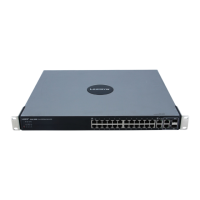3-18
Cisco Wireless LAN Controller Configuration Guide
OL-9141-03
Chapter 3 Configuring Ports and Interfaces
Configuring Dynamic Interfaces
Step 4 Enter these commands to configure dynamic interfaces:
• config interface create operator-defined-interface-name {vlan-id | x}
Note Enter a non-zero value for the VLAN identifier. Tagged VLANs must be used for dynamic
interfaces.
• config interface address operator-defined-interface-name ip-addr ip-netmask [gateway]
• config interface vlan operator-defined-interface-name {vlan-id | 0}
• config interface port operator-defined-interface-name physical-ds-port-number
• config interface dhcp operator-defined-interface-name ip-address-of-primary-dhcp-server
[ip-address-of-secondary-dhcp-server]
• config interface operator-defined-interface-name quarantine enable
Note Use this command if you want to configure this VLAN as unhealthy. Doing so causes the
data traffic of any client that is assigned to this VLAN to pass through the controller, even
if the WLAN is configured for local switching. This command is generally used for clients
that are associated to a hybrid-REAP access point and the access point’s controller is
configured for network access control (NAC). See Chapter 12 for more information on
hybrid REAP.
• config interface acl operator-defined-interface-name access-control-list-name
Note See Chapter 5 for more information on ACLs.
Step 5 Enter save config to save your changes.
Step 6 Enter show interface detailed operator-defined-interface-name and show interface summary to verify
that your changes have been saved.
Note If desired, you can enter config interface delete operator-defined-interface-name to delete a dynamic
interface.

